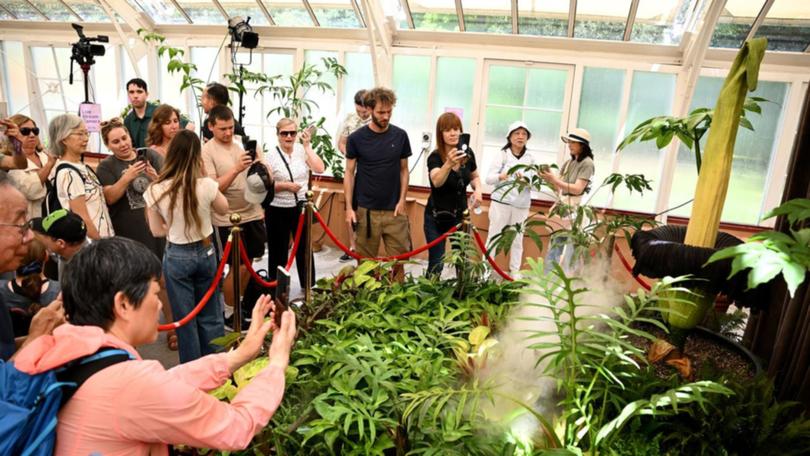Putricia the ‘corpse flower’ pulls a crowd of 27,000 keen for a whiff at Sydney’s Botanical Gardens

In a phenomenon almost as rare as the stinky flower itself, online engagement generated by a rare blooming of a botanical sensation has created a community of passionate young “plant people”.
Some 27,000 people showed up and waited up to three-and-a-half hours to see - and smell - the full spectacle of the corpse flower, nicknamed “Putricia”, unfurling at Sydney’s Royal Botanic Gardens last week.
It was the biggest public event in the gardens’ 209-year history, says its director of horticulture and living collections, John Siemon, and the arrival of the crowds felt “like a tsunami wave in the gardens”.
Sign up to The Nightly's newsletters.
Get the first look at the digital newspaper, curated daily stories and breaking headlines delivered to your inbox.
By continuing you agree to our Terms and Privacy Policy.Even more extraordinary was the 1.7 million people who tuned into the live stream of the rare botanical sensation.
“For a while we thought we put it on display too early,” Mr Siemon told AAP.
“But the flip side of that was that it created this wonderful community of like-minded individuals who built this behemoth of social media engagement.
“They were watching 24/seven. I had people reporting they were going to sleep with iPads on their beds, setting alarms to wake up to make sure that they didn’t miss the bloom. It was just this wonderful phenomenon.”
The rare titan arum, a type of carrion flower, has the world’s largest and stinkiest flower spike and blooms for only 24 hours.
By the time it did, Mr Siemon and his co-workers had been given nicknames like “the handmaidens” and “Kevin from accounts” by the online community who were commenting on the live stream.
The queues at the Royal Botanic Gardens were filled with people from every stage of life - preschoolers to retirees all waiting patiently together, but online the worldwide demographic was distinctly young, Mr Siemon says.
Fans who went to see Putricia IRL (or ‘in real life’) turned their social media experience into a simply social one.
“Many found innovative ways to find each other,” Mr Siemon explains.
“From anonymous profiles online they formed the letter ‘A’, like the Amorphophallus shape, in the crowd and were identifying themselves and meeting up and gathering to get photos in front of the flower.
“Then they carried on with this wonderful community of like-minded plant people throughout the rest of the blooming process.
“It was superb. I think we’re still blown away by the level of engagement.”
Found only in the rainforests of western Sumatra, the corpse flower gets its name from the smell of putrid, rotting flesh it exudes when it blooms.
Its purpose is to lure pollinators that feed on flesh, such as flies and beetles, but without the right pollinators or another male plant nearby, the team from the Royal Botanic Gardens had to step in to assist with hand-pollination.
When it first bloomed, they applied pollen from the male organs of a flower that bloomed last year to the female parts of Putricia in the hope of harvesting about 400 berries that could be shared with gardens worldwide.
About 24 hours later, when the male organs of Putricia burst forth, oozing out pollen “like a pimple”, the team used dessert spoons to collect it up and stored away for future conservation projects.
Mr Siemon is hopeful the conversation that has started with Putricia’s bloom continues to drive interest in saving this and other species of plants on the brink of extinction.
A second corpse flower is expected to bloom in the coming weeks, but the team may not open it to the public, instead focusing on the science and getting “up close and personal” with the rare bloom.
But given the online furore, a livestream may be announced to appease the corpse flower fans, Mr Siemon says.
“So, after 15 years of not having one, we’re going to have two in quick succession,” he said.
“Which is slightly frightening after the impact of the first one.”
